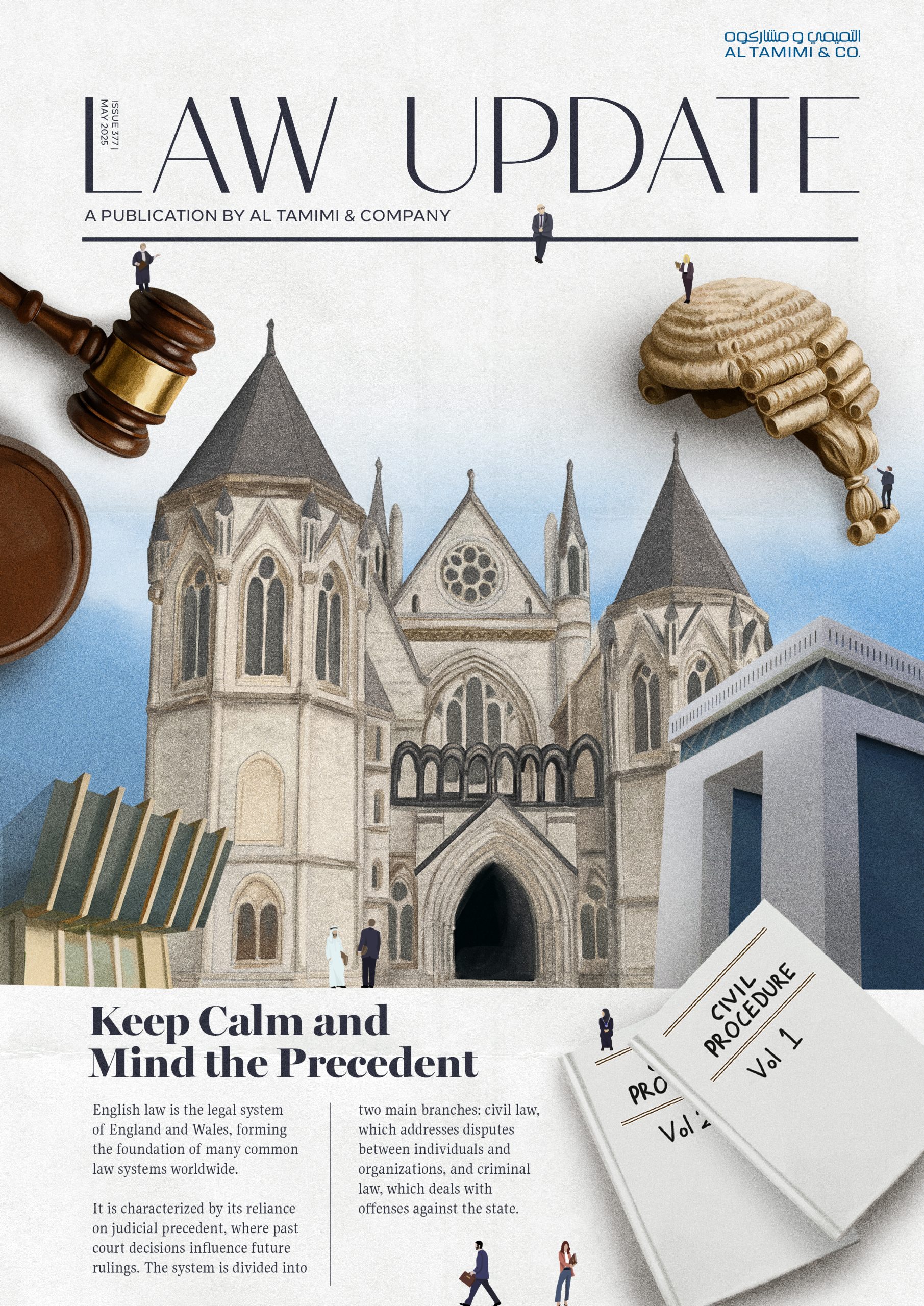- Arbitration
- Banking & Finance
- Capital Markets
- Commercial
- Competition
- Construction & Infrastructure
- Corporate / Mergers & Acquisitions
- Corporate Services
- Corporate Structuring
- Digital & Data
- Dispute Resolution
- Employment & Incentives
- Family Business & Private Wealth
- Innovation, Patents & Industrial Property (3IP)
- Insurance
Find a Lawyer
Book an appointment with us, or search the directory to find the right lawyer for you directly through the app.
Find out more
English Law: Keep calm and mind the precedent
In May Law Update’s edition, we examined the continued relevance of English law across MENA jurisdictions and why it remains a cornerstone of commercial transactions, dispute resolution, and cross-border deal structuring.
From the Dubai Court’s recognition of Without Prejudice communications to anti-sandbagging clauses, ESG, joint ventures, and the classification of warranties, our contributors explore how English legal concepts are being applied, interpreted, and adapted in a regional context.
With expert insight across sectors, including capital markets, corporate acquisitions, and estate planning, this issue underscores that familiarity with English law is no longer optional for businesses in MENA. It is essential.


2025 is set to be a game-changer for the MENA region, with legal and regulatory shifts from 2024 continuing to reshape its economic landscape. Saudi Arabia, the UAE, Egypt, Iraq, Qatar, and Bahrain are all implementing groundbreaking reforms in sustainable financing, investment laws, labor regulations, and dispute resolution. As the region positions itself for deeper global integration, businesses must adapt to a rapidly evolving legal environment.
Our Eyes on 2025 publication provides essential insights and practical guidance on the key legal updates shaping the year ahead—equipping you with the knowledge to stay ahead in this dynamic market.
The leading law firm in the Middle East & North Africa region.
A complete spectrum of legal services across jurisdictions in the Middle East & North Africa.
-
Practices
- All Practices
- Banking & Finance
- Capital Markets
- Commercial
- Competition
- Construction & Infrastructure
- Corporate / Mergers & Acquisitions
- Corporate Services
- Corporate Structuring
-
Sectors
-
Country Groups
-
Client Solutions
Today's news and tomorrow's trends from around the region.
17 offices across the Middle East & North Africa.
Our Services
 Back
Back
-
Practices
- All Practices
- Banking & Finance
- Capital Markets
- Commercial
- Competition
- Construction & Infrastructure
- Corporate / Mergers & Acquisitions
- Corporate Services
- Corporate Structuring
- Digital & Data
- Dispute Resolution
- Employment & Incentives
- Family Business & Private Wealth
- Innovation, Patents & Industrial Property (3IP)
- Insurance
- Intellectual Property
- Legislative Drafting
- Private Client Services
- Private Equity
- Private Notary
- Projects
- Real Estate
- Regulatory
- Tax
- Turnaround, Restructuring & Insolvency
- Compliance, Investigations and White-Collar Crime
-
Sectors
-
Country Groups
-
Client Solutions

The Dubai Court of Cassation clarifies the Position on the Interpretation of Back-to-Back Clauses
 Introduction
Introduction
Back-to-back clauses are a regular feature in, not only, construction but also general commercial agreements. Although, they may come in different variations tailored to specific contracts, a back-to-back clause is in broad terms, an agreement that a Sub-contractor will not be entitled to payment from a Main Contractor unless payment has been received by the ultimate client or Employer.
The interpretation of back-to-back clauses has long been a contested issue in commercial and construction disputes, the latest being the Dubai Court of Cassation judgment in which Al Tamimi successfully acted for a main contractor (overturning the First Instance and Court of Appeal judgments), that provides helpful guidance on how back-to-back clauses will be interpreted by the Dubai Courts.
Dubai Court of First Instance
The Sub-contractor commenced proceedings before Dubai’s Court of First Instance requesting the court to order the Main Contractor to pay an outstanding amount for the delivered sub-contracted works. The Main Contractor, at this point represented by another law firm, contended in its defence that the claim was premature on the basis of that the equivalent payment had not been received from the Employer and, therefore, the obligation to pay the Sub-contractor had not arisen pursuant to the back-to-back clause and accordingly requested the court to dismiss the case.
The Dubai Court of First Instance appointed an accounting expert in order to examine the matter and provide a report to the court. Notwithstanding the back-to-back clause and the fact that the Main Contractor had not received all of the equivalent payments from the Employer, the expert concluded that the sub-contractor was entitled to receive the entire claimed amount from the Main Contractor. In the report, the expert took into account the amounts received under the two contracts (the main contract and the Sub-contract). Further, the expert concluded that the percentage of payments received by the Main Contractor from the Employer (in relation to the main contract works) was slightly higher than the percentage of the payments received by the Sub-contractor from the Main Contractor, in relation to the sub-contracted works.
The Main Contractor objected to the expert’s report. However, the Dubai Court of First Instance decided to reject the Main Contractor’s prematurity plea, issuing its judgment following the expert’s finding and ordered the Main Contractor to pay the claimed amount to the Sub-contractor in addition to nine percent legal interest.
Dubai Court of Appeal
The Main Contractor, which was represented by Al Tamimi from the Court of Appeal stage, challenged the first instance judgment before the Dubai Court of Appeal and insisted on the prematurity plea on the basis that the back-to-back clause had not been correctly interpreted by the Court below.
The Main Contractor also pleaded other procedural irregularities in the expert’s report and requested the appointment of a new expert. The Court of Appeal decided, however to refer the matter back to the same expert in order to examine the objections. The expert submitted a supplementary report before the Court of Appeal in which he confirmed the initial expert’s findings, concluding that the Main Contractor should pay the Sub-contractor the claimed amount on the basis that the Main Contractor had received more payments from the Employer than it had passed on to the Sub-contractor.
Further arguments and objections were raised as follows:
- the expert had taken into account funds received by the Employer in respect of a completely different project, when determining that the Main Contractor had been ‘paid’ by the Employer and that therefore payment was due to the Sub-contractor;
- the Main Contractor had been successful in an arbitration against the Employer (but not recovered), for non-payment in respect of the same project. This supported the Main Contractor’s position that it had not yet received the relevant payments, which included the amounts claimed by the Sub-contractor.
Despite the these objections, the Court of Appeal rejected the Main Contractor’s prematurity plea and decided to uphold the Court of First Instance judgment to order the Main Contractor to pay the claimed amount.
Dubai Court of Cassation
The Main Contractor appealed the Court of Appeal’s judgment before the Court of Cassation on the following grounds:
- the sub-contract includes a back-to-back clause, which makes it a prerequisite for the Main Contractor to be paid, before the payment is due to the Sub-contractor, as the Main Contractor had not been paid the equivalent sum, the payment was not due. The Court below had erred in interpreting the back-to-back clause;
- the expert erred in this report and there was no evidence that the Main Contractor had been paid the equivalent sum by the Employer. Further, the expert’s report relied on incorrect assumptions and considered payments from another project; and
- the Sub-contractor, on whom the burden of proof lay, did not establish that the condition of the back-to-back clause was satisfied;
The Dubai Court of Cassation accepted the Main Contractor’s arguments and overturned the lower courts’ judgments and accordingly decided to dismiss the Sub-contractor’s claim on the basis of prematurity and the existence of the back-to-back clause in the sub-contract.
In its judgment, the Court of Cassation relied on the following key provision of the UAE Civil Transactions law No. (5) of 1985, as amended:
Article 420:
A Condition is a future matter upon the existence or absence of which the full effectiveness (of a disposition) depends.
Article 429:
It shall be permissible to defer a disposition to a future time, upon the coming of which the provisions (of the disposition) shall become effective or be extinguished.
Comments and Conclusion
In our view, there may be some changes to the effectiveness and enforcement of back-to-back clauses from a practical point of view. One of those challenges includes the way in which different parties view and interpret the back-to-back arrangement. In our experience, we have come across certain experts who disregard such contractual provisions (including a back-to-back clause). It is our view that the judicial shift, prior to this decision, had been to support the weaker party (such as a sub-contractor) by ordering payment for services performed notwithstanding the existence of a back-to-back clause.
This has caused some concern in the legal community (and, indeed, was leading to uncertainty) and therefore the present judgment provides welcome clarity that contractual provisions will be enforced. The back-to-back arrangement is key in certain industries such as construction and as such should be upheld, especially when express provisions are included in the contracts.
It is for this reason that it is now increasingly important for back-to-back clauses to be carefully drafted in order to avoid the potential for conflicting interpretations and fundamental disagreements as to what is intended by this type of arrangement. This Dubai Court of Cassation judgment is helpful in establishing that the Courts will continue to recognise and apply the back-to-back arrangement, provided that challenges are raised in a timely manner.
Al Tamimi & Company’s Litigation team regularly advises in commercial disputes before the onshore and DIFC Courts. For further information please contact Diego Carmona (d.carmona@tamimi.com), Mohamed Selim (m.selim@tamimi.com) or Mohieeldin ElBana (m.elbana@tamimi.com).
Stay updated
To learn more about our services and get the latest legal insights from across the Middle East and North Africa region, click on the link below.


